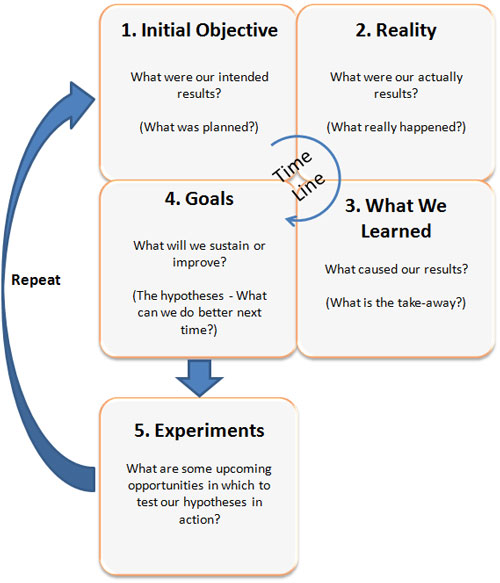There has been some discussion recently that as the world gets more complex, formal learning becomes less relevant. However, complex environments imply an "emerging practice," which in turn implies a customary way of operation or performance. Yes, they may be still emerging, but unless these emerging practices are dealt with in a manner that ensures they do indeed become a customary way of doing things, they will soon turn to chaos if left to chance.
For example, I used to work in a manufacturing environment in which our products had a relative firm foothold in our section of the food industry. Mostly because it was new. Thus with little competition we could take our sweet time in how we dealt with growing and moving forward. However, as we become more successful, other companies, both large and small, soon moved into our niche. Thus in order to stay ahead of them we had to produce faster, cheaper, and with more variety; all while still maintaining the quality that our products were known for. Almost every other month we were moving onto something new, such as Lean and Just-in-Time on the manufacturing side and engagement and communication theories on the OD side in order to ward off the increasing intense competition. Basically we would at first embrace the entire concept for a short while and then examine what worked best for us and what had little or negative impacts, and then shed the unworthy ones.

All of this required some sort of formal learning so that we could produce quality products consistently. This process worked similar to Boyd's OODA Loop:
- Observe — What best or emerging practice can best help us?
- Orient — Test it out to get the proper context.
- Decide — What parts work best (shed the mediocre)?
- Act — Establish it as a practice (normally with the help of formal learning)
Of course the training we provided had to be created and implemented rapidly and was often done through the use of small chunks. Anything less would only lead to chaos.
The other part of a complex environment is providing better means of informal learning as all this learning taking place would be quite inefficient if placed in a formal learning platform. This means that you must not only support the formal learning though faster and smaller learning chunks, but also support the ever increasing informal learning. One way of accomplishing this is through the use of a three-prong process: 1) capture the Lessons Learned, 2) store it in a social site for easy retrieval, and 3) provide a microblogging tool to help others to learn about recent lessons learned.
AAR
As noted in my last post, informal learning can be just as expensive as formal learning, thus the need to get more bang for your bucks. Part of its inefficiency is capturing lessons learned. That is, while a person or small group may learn something new, that learning is rarely or never passed on to others in the organization. Thus while there may be a lot of informal learning occurring, a lot of it are repeats. One of the best means for combating this is through After Action Reviews (AAR). You can help "push" AARs into the working environment through formal learning, such as:
- Classroom — Having the learners discovering which of their projects make good candidate for running through an AAR.
- eLearning — Once their projects are nearing their completion, then they receive some just-in-time training for:
- Questioning Techniques — Using scenarios, such as, rather than asking, “Robert, why did your equipment operators remove the safety guards from the equipment?,” they select, “Robert, can you tell us about your recent safety inspection?”
- Using the four basic steps of an AAR:

- Capturing the results of the four steps through mind maps that keep the steps aligned and use a visual mode that allows other learners to more easily understand them.
Wikis
Once the learners have learned to capture Lessons Learned and then actually put it to practice, they need to move them to a storage site, such as a wiki or SharePoint so others may learn from them. Throughout my travels I have noted that some of the most barren social media sites are often corporate wikis. This is because most were implemented in the same manner as the old Knowledge Management systems were — write your knowledge down and then put it in the wiki. Yet, as we soon learned, people don't want to waste their time creating content that someone MIGHT use. But fortunately, using a wiki as a site for Lessons Learned is the perfect vehicle as the content have already been created through the AAR process and what the participants have learned will more than likely be needed by others.
Microblogging
In addition, we need one more tool for carry the Lessons Learned forward — a microblogging tool such as Twitter, Yammer, Present.ly, Socialcast, or Socialwok. While some of the lessons learned may require formal learning techniques, the majority do not. However, simply putting them in a wiki or SharePoint is not enough as people who have done similar projects in the past and are about to start a new project do not normally go digging through sites to see if something new has been learned. Thus such microblogging tools are invaluable for:
- People completing a project — they can send a tweet to broadcast the highlights of Lessons Learned that put others in the loop.
- People starting a new project — they can announce their new project and ask if there is something has recently been learned about implementing such projects.
Now while some people and indeed, entire groups or teams will naturally take to such microblogging tools, others will not. Thus you have to know your learners — do they need help with learning the new technology? Don't stop with just a class. Ensure you push the learning into the workplace by requiring them to complete x number of tweets per week, or asking x number of questions and tweeting x number of recent learnings.
Hopefully this three step process will be useful in your quest to support informal learning by capturing the Lessons Learned through the use of an AAR, storing it in a social site, such as a wiki or SharePoint for easy retrieval, and then providing a microblogging tool, such or Twitter or Yammer, to help others to learn about recent lessons learned.
How do you plan on supporting the informal?




